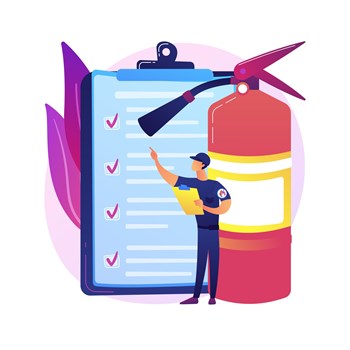
Among the many hazards that can threaten any multifamily building, fire ranks right at the top. Local news is replete with stories about the property loss, structural damage, and even death that a fire can cause. While horrific in small properties, fire can be even more dangerous in multifamily buildings. High-rises in particular can pose unique challenges when it comes to fire safety—and meeting those challenges can literally be a matter of life and death.
Causes
All kinds of mishaps and malfunctions can cause fires—even a minor human or mechanical error can lead to a deadly conflagration.
“The most common causes are simple things, like candles and extension cords, or leaving a pot on the stove and forgetting about it,” says Matt Welhaf, assistant fire chief for Highland Beach Fire Rescue, located in Highland Beach, Florida.
“Cooking fires are the most common type in residential buildings,” adds Jim Bullock, a retired fire chief and president of NY Fire Consultants, Inc. in New York City. “Heating fires, other unintentional, careless fires, and electrical malfunction fires are also common. But, the total of these three types of fires together doesn’t reach the number of cooking fires.”
“Fires caused by cooking, heating equipment, and electrical equipment often are caused by faulty wiring, loose connections, or even the overuse of plug strips and extension cords,” agrees Rick Thyne, proprietor of Thyne Electric & Alarms, located in Dracut, Massachusetts. “Heaters—especially plug-in space heaters too close to combustible items, like clothes or drapes–can combust. Electric baseboard heat with combustibles too close or even thrown on top of them are also a hazard. Many people are unaware that you can’t drape curtains or have furniture right up against an electric baseboard.”
Another cause of fires, one which is becoming more and more common, is the use—and often, the misuse—of lithium-ion batteries, which power e-bikes, scooters, and other rechargeable vehicles.
“There is much concern about lithium batteries,” says Welhaf. “Florida has recently held two symposiums on the subject where experts talked about how to put out these unique types of fires. With the increase in the use of electric vehicles and EV charging systems, the potential for increased fire risk is built into new building codes in any and all parking garages. Equipment must match manufacturer suggested specs and national electric codes. A vehicle fire in a parking structure would be significant. They burn at super high heat, and existing sprinkler systems can’t handle it.”
“Another big factor in how bad a fire can get is if it begins in one of the ‘wrong’ places,” Welhaf continues. “Places where it’s not immediately detected or noticed, like mechanical rooms, or air conditioning rooms. Motors [in those areas] often break down and may ignite a fire.” If nobody’s around to notice, a smolder can easily turn into a blaze before anyone is the wiser that there’s even a problem.
Protecting Person & Property
Perhaps the most important component in fire safety is having a plan of action and knowing what to do if a blaze breaks out. Evacuation, especially in a multifamily building, is critical to protecting life and limb.
“Most residents typically use an elevator to get to and from their apartments,” says Bullock. “But in the case of a fire, that would be disastrous. Residents need to know where the stairs are, and where they lead. Other important information residents need to know is whether the building is combustible (non-fireproof) or non-combustible (fireproof). If the building is combustible, at the first signs of smoke or fire you should immediately leave the building. In a combustible building, the building itself burns in the event of a fire. In a non-combustible building, only the contents of the building burn, while the structural components do not.”
“Have a plan of action. Know your exits,” agrees Welhaf, “two per floor, minimum. Be prepared to use them. Pay attention to the alarm system. There will be voice instructions as the crisis happens; do as you’re instructed, particularly in high-rise properties. Have a plan with your family and neighbors to meet outside at a specified location so you can account for each other. Each floor should have a floor captain, to ensure that everybody is accounted for. If someone is missing, notify someone in the fire force to check in certain units when possible. ”
“A clear and well-communicated fire safety plan is crucial for multifamily buildings,” says Randy Triolo, Director of Risk Management for FirstService Residential in New Jersey. “Such a plan can significantly reduce the risk of injuries and property damage in case of a fire. A well-defined evacuation plan ensures that residents can quickly and safely exit the building in case of a fire. Further, a well-communicated plan allows building management and emergency responders to coordinate efforts efficiently. This includes clear communication channels, designated assembly points, and procedures for accounting for all residents.”
Thyne, with extensive on-the-ground experience, notes that “the plan of action will differ for every building, so it’s important to come up with a unique set of guidelines for your particular location. For example, most multifamily buildings consist of many levels and will feature a front stairwell, a rear stairwell, and/or common hallways. Residents need to be familiarized with these common areas so they know how to properly escape the building in an orderly fashion. Residents should be encouraged to attend meetings on this plan of action at least annually, or at the very least clear communication of the plan of action should be distributed via notices and emails, etc.”
Fire Evacuation Plans
Having a plan is ground zero to saving lives. So what should that plan look like?
“The building owner or the board of directors in a co-op or condominium is responsible for preparing a plan,” says Bullock. “It is in everyone’s best interest to have an individual apartment plan and drill. This should be practiced at least once a year. In New York City, owners are required to compile a Fire Emergency Preparedness Guide. Sadly, in my experience, many Fire Emergency Preparedness Guides are prepared incorrectly, or are incomplete. These guides should be prepared by a fire professional.”
Plans should also address different types of fires, where they might originate, and under what circumstances one should evacuate or remain in their apartment. Whether you stay or flee depends on where the fire is located, Bullock explains. “If the fire is in your apartment, you should leave immediately. If the fire is not in your apartment and you are not in immediate danger, it is most likely safer to stay put rather than enter a hallway and/or the interior stairs full of high heat and toxic smoke.”
Inspections
Buildings and their mechanical and electrical systems age, of course—and as they do, can become fire hazards. That’s why all buildings should be inspected regularly for fire safety and preparedness. Vigilance is everything. Inspection requirements may vary by state and locality, but one thing the fire pros agree on is having regular, thorough fire inspections conducted by a knowledgeable, competent professional.
“Hire a qualified fire safety inspector,” says Triolo. “They can conduct a thorough inspection of your property, identifying potential fire hazards and recommending corrective actions. Also, many local fire departments offer inspection services and can provide valuable advice on fire safety. It’s important to conduct routine inspections of fire safety equipment, such as smoke detectors, fire extinguishers, and sprinkler systems. Look for potential hazards like flammable materials, faulty wiring, and blocked exits.”
“Fire departments are your best resource,” says Welhaf. He strongly suggests that your fire safety plan be coordinated onsite and with management to provide details and verification procedures. In his community, annual inspections are required, and management is required by the fire code to have a plan, much like in a hotel.
Bullock agrees. “Buildings should have a fire professional conduct a fire and life safety building inspection every few years. This will point out dangerous conditions. A few years ago, 18 occupants of an NYC building perished on the upper floors when a fire started on a lower floor. In New York City, stairways and apartment doors are required to be self-closing, but in that tragic situation, not all the doors closed fully, causing heavy toxic smoke to spread throughout the building. The doors hadn’t been inspected regularly to see if they functioned according to code.”
“The fire departments we’ve worked with to design and install fire alarm systems in both Massachusetts and New Hampshire have been more than helpful when it comes to developing a plan of action for saving lives,” says Thyne. “As far as being on-site in the event of a fire emergency, there are members of the board that could get the call to come down and try to help first responders due to their knowledge of the building. But in reality, there is no telling what time a catastrophic event such as a fire may happen, or who may be there when it does, so the first responders will do their best to help regardless.”
Potential Liability
Boards and managers of multifamily buildings can face significant liability if they neglect to implement fire prevention measures or fail to communicate and drill evacuation plans with residents. According to Triollo, some potential legal consequences include:
• Personal Injury Lawsuits: If a fire occurs due to negligence, individuals injured in the fire may sue the property owners or managers.
• Property Damage Lawsuits: Property owners and tenants may sue for damages to their property caused by the fire.
• Criminal Charges: In severe cases of negligence, individuals may face criminal charges, such as reckless endangerment or involuntary manslaughter.
Adhering to fire code regulations is essential to protect lives and property, but also to avoid liability as well.
The potential for a fire may be the farthest thing in your mind on a daily basis, but their rarity doesn’t mitigate their capacity to wreak havoc on lives–or even end them. Oftentimes fires are small and manageable and there’s no loss of life. Other times, they become disasters. The key to reducing the likelihood of either type is planning, communication, and vigilance.
A J Sidransky is a staff writer/reporter for CooperatorNews, and a published novelist. He may be reached at alan@yrinc.com.






Leave a Comment